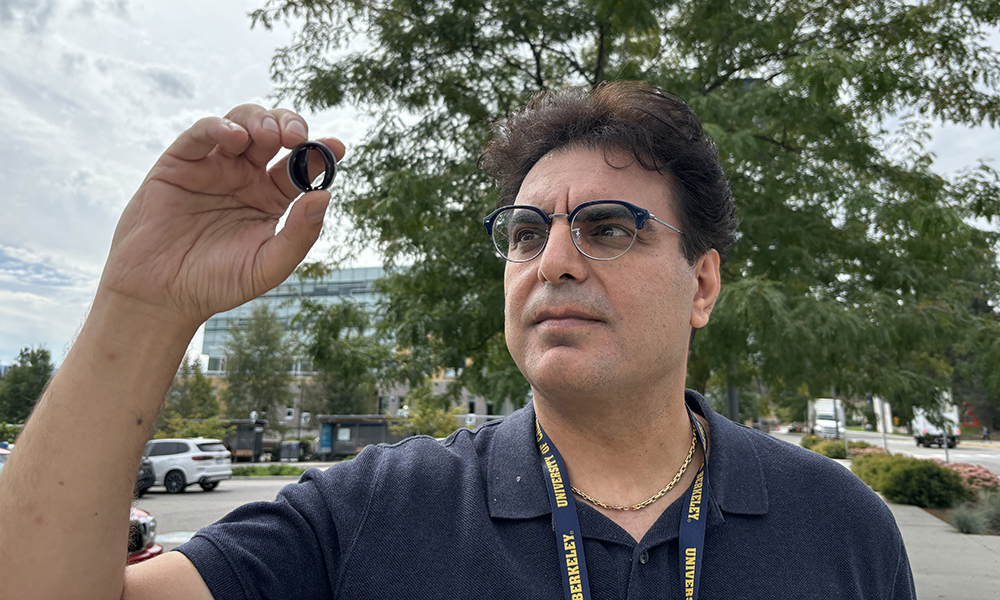
UBCO's Dr. Hadi Mohammadi holds his latest innovation-a manufactured heart valve that combines the best of both tissue and mechanical technologies-that may eventually out-perform current valves.
When a patient needs a new heart valve, the current mechanical and tissue replacements each have strengths and weaknesses.
Now, a team of UBC Okanagan researchers believe they have found a way to harness the strengths of both technologies in a way that could be life-changing-and life-saving-for many. Dr. Hadi Mohammadi and his fellow researchers in the Heart Valve Performance Laboratory at UBC Okanagan are focused on developing the mechanical heart valves of the future.
Dr. Mohammadi, an Associate Professor with the School of Engineering, says their latest work, dubbed the iValve, is their most advanced yet and combines the best of both technologies-mechanical and tissue-when it comes to replacement heart valves.
"Tissue valves generally perform better than mechanical valves because of their shape, but last only 15 to 20 years on average, which would require another replacement. Mechanical valves can last a lifetime, but do not perform as well as tissue valves, requiring patients to take daily anticoagulants," says Dr. Mohammadi.
"We have produced a new mechanical heart valve that combines the best of both worlds-offering the performance of tissue valves with the long-lasting durability of mechanical valves. We believe this valve could make life easier and safer for patients," he adds.
The breakthrough valve was made possible through an international collaboration with ViVitro Labs and independent consultants Lawrence Scotten and Rolland Siegel. The research was funded by Angeleno Medical and published this month in the Journal of Biomechanics.
"This is the only valve of its kind to be designed and built in Canada," notes Dr. Mohammadi. "We are incredibly proud of this valve as an example of the engineering innovation coming from UBC and Canada."
Dr. Mohammadi also says while mechanical heart valve replacements have long been in use, the long-standing challenge has been to perfect the technology for the smallest hearts-tiny infants.
"What is particularly exciting about the iValve, is that it was specifically designed for high-heart-rate applications, such as in pediatric patients," explains Dr. Mohammadi.
Now that their prototype performs well in mechanical lab tests, the researchers will bring it to animal and clinical trials. If all goes well, they hope the iValve could be ready for those trials within two years.
In the meantime, they will also be using the technology and techniques to develop new valves.
"This valve is designed to allow blood flow to the aorta, which is the body's largest artery, and the blood vessel that carries oxygen-rich blood away from the heart throughout your body," explains Mohammadi. "Next, we will take what we have learned and develop one for the mitral valve. That valve is responsible for making sure that blood flows from your left atrium to your left ventricle. It also ensures that blood doesn't flow backward between those two chambers."
Heart Valve Performance Lab Manager Dr. Dylan Goode is excited about what the future holds for the iValve-and for the benefits it could bring to patients.
Dr. Goode began working with Dr. Mohammadi in 2018 while completing his Master of Applied Science in Mechanical Engineering. Recently, he successfully defended his doctoral dissertation, which documents his design work, fabrication and testing of the iValve.
"We have shown that the iValve can provide the structural benefits of a mechanical heart valve and last a patient's lifespan while providing improved hemodynamic performance, meaning an improvement of the way in which blood flows through vessels."
Dr. Goode notes the new iValve could also mean a major improvement in lifestyle for these patients who endure a routine of regular anticoagulant therapy-blood thinners-which can increase their risk of severe bleeding, blood clots or damage to tissues and organs if blood flow is impeded.






